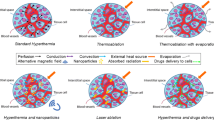Abstract
Cancer is one of the most death-causing diseases across the world. Radiotherapy is an important modality with which it is treated. In the present study, temperature distributions due to the application of radiation on skin are estimated using parabolic and hyperbolic models of heat transfer and are compared as to which one better estimates the practical temperature distribution. From the temperature distributions obtained, it can be inferred that parabolic and hyperbolic models produce similar results for smaller phase lag times, while they predict significantly different results when the lag times are large, suggesting that hyperbolic models are suitable to be used for biological systems with very complex internal structure. Thermal damage is also calculated for three different models of heat transfer. It is observed that thermal wave model predicts higher damage, followed by dual phase lag model and Pennes model. Time required for tumor necrosis is more for higher phase lag values, suggesting longer radiation exposure durations for treating complex biological systems. When phase lag times for heat flux and temperature gradient are equal, both dual phase lag model and Pennes model have shown similar results. Effect of Gaussian distribution of applied heat flux on time required for tumor necrosis is also studied.















Similar content being viewed by others
References
GLOBOCAN (2008) Cancer incidence and mortality worldwide. https://www.iarc.fr/en/media-centre/iarcnews/2010/globocan2008.php. Accessed 09 July 2018
Delaney G, Jacob S, Featherstone C, Barton M (2005) The role of radiotherapy in cancer treatment: estimating optimal utilization from a review of evidence-based clinical guidelines. Cancer 104(6):1129–1137
Barnett GC et al (2009) Normal tissue reactions to radiotherapy: towards tailoring treatment dose by genotype. Nat Rev Cancer 9(2):134–142
Bleehen NM (1982) Hyperthermia in the treatment of cancer. Br J Cancer 45:96
Pennes HH (1948) Analysis of tissue and arterial blood temperatures in the resting human forearm. Appl Physiol 1(2):93–122
Cattaneo C (1958) A form of heat-conduction equations which eliminates the paradox of instantaneous propagation. Comptes Rendus 247:431–433
Mitra K, Kumar S, Vedevarz A, Moallemi MK (1995) Experimental evidence of hyperbolic heat conduction in processed meat. J Heat Transf 117(3):568
Kaminski W (1990) Hyperbolic heat conduction equation for materials with a nonhomogeneous inner structure. J Heat Transf 112(3):555
Herwig H, Beckert K (2000) Experimental evidence about the controversy concerning Fourier or non-Fourier heat conduction in materials with a nonhomogeneous inner structure. Heat mass Transf 36:387–392
Graûmann A, Peters F (1999) Experimental investigation of heat conduction in wet sand. Heat Mass Transf 35:1–6
Minkowycz WJ, Haji-Sheikh A, Vafai K (1999) On departure from local thermal equilibrium in porous media due to a rapidly changing heat source: the Sparrow number. Int J Heat Mass Transf 42:3373–3385
Hooshmand P, Moradi A, Khezry B (2015) Bioheat transfer analysis of biological tissues induced by laser irradiation. Int J Therm Sci 90:214–223
Zhou J, Zhang Y, Chen JK (2009) An axisymmetric dual-phase-lag bioheat model for laser heating of living tissues. Int J Therm Sci 48(8):1477–1485
Liu K, Wang J (2014) Analysis of thermal damage to laser irradiated tissue based on the dual-phase-lag model. Int J Heat Mass Transf 70:621–628
Antaki PJ (2005) New interpretation of non-Fourier heat conduction in processed meat. J Heat Transf 127(2):189
Museux N, Perez L, Autrique L, Agay D (2012) Skin burns after laser exposure: histological analysis and predictive simulation. Burns 38(5):658–667
Jiang SC, Ma N, Li HJ, Zhang XX (2002) Effects of thermal properties and geometrical dimensions on skin burn injuries. Burns 28(8):713–717
Bedin L, Bazán FSV (2014) On the 2D bioheat equation with convective boundary conditions and its numerical realization via a highly accurate approach. Appl Math Comput 236:422–436
Tung MM, Trujillo M, LópezMolina JA, Rivera MJ, Berjano EJ (2009) Modeling the heating of biological tissue based on the hyperbolic heat transfer equation. Math Comput Model 50(5–6):665–672
Ahmadikia H, Fazlali R, Moradi A (2012) Analytical solution of the parabolic and hyperbolic heat transfer equations with constant and transient heat flux conditions on skin tissue. Int Commun Heat Mass Transf 39(1):121–130
Lakhssassi EK, Semmaoui H (2010) Investigation of nonlinear temperature distribution in biological tissues by using bioheat transfer equation of Pennes’ type. Nat Sci 2(3):131–138
Deng ZS, Liu J (2004) Mathematical modeling of temperature mapping over skin surface and its implementation in thermal disease diagnostics. Comput Biol Med 34(6):495–521
Henriques R Jr, Moritz FC (1947) Studies of thermal injury: I. The conduction of heat to and through skin and the temperatures attained therein. A theoretical and an experimental investigation. Am J Pathol 23(4):530
Verma K, Rath P, Mahapatra SK (2017) Assessment of thermal damage during skin tumor treatment using thermal wave model: a realistic approach. J Heat Transf 139(5):051102
Li J, Cheng P, Peterson GP, Xu JZ (2005) Rapid transient heat conduction in multilayer materials with pulsed heating boundary. Numer Heat Transf Part A Appl 47(7):633–652
Deng Z-S, Liu J (2002) Analytical study on bioheat transfer problems with spatial or transient heating on skin surface or inside biological bodies. J Biomech Eng 124(6):638
Zhang Y (2009) Generalized dual-phase lag bioheat equations based on nonequilibrium heat transfer in living biological tissues. Int J Heat Mass Transf 52(21–22):4829–4834
Acknowledgement
This research was supported by National Institute of Technology Karnataka, Surathkal. We extend our thanks to Prof. Prasenjith Rath, IIT Bhuvaneshwar, for his valuable comments.
Author information
Authors and Affiliations
Corresponding author
Ethics declarations
Conflict of interest
We declare that we do not have any commercial or associative interest that represents a conflict of interest in connection with the work submitted.
Additional information
Technical Editor: Adriano Almeida Gonçalves Siqueira.
Publisher's Note
Springer Nature remains neutral with regard to jurisdictional claims in published maps and institutional affiliations.
Rights and permissions
About this article
Cite this article
Akula, S.C., Maniyeri, R. Numerical simulation of bioheat transfer: a comparative study on hyperbolic and parabolic heat conduction. J Braz. Soc. Mech. Sci. Eng. 42, 62 (2020). https://doi.org/10.1007/s40430-019-2132-x
Received:
Accepted:
Published:
DOI: https://doi.org/10.1007/s40430-019-2132-x




